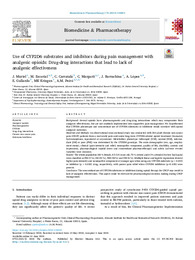Please use this identifier to cite or link to this item:
https://hdl.handle.net/11000/32544Full metadata record
| DC Field | Value | Language |
|---|---|---|
| dc.contributor.author | Muriel, J | - |
| dc.contributor.author | Escorial, Mónica | - |
| dc.contributor.author | Carratalá, C | - |
| dc.contributor.author | Margarit, César | - |
| dc.contributor.author | Barrachina, Jordi | - |
| dc.contributor.author | López, A | - |
| dc.contributor.author | Kringen, Marianne K | - |
| dc.contributor.author | Peiró, Ana | - |
| dc.contributor.other | Departamentos de la UMH::Farmacología, Pediatría y Química Orgánica | - |
| dc.date.accessioned | 2024-07-18T10:26:59Z | - |
| dc.date.available | 2024-07-18T10:26:59Z | - |
| dc.date.created | 2024-06-14 | - |
| dc.identifier.citation | Biomed Pharmacother. 2024 Jul:176:116882 | es_ES |
| dc.identifier.issn | 0753-3322 | - |
| dc.identifier.uri | https://hdl.handle.net/11000/32544 | - |
| dc.description.abstract | Background: Several opioids have pharmacogenetic and drug-drug interactions which may compromise their analgesic effectiveness, but are not routinely implemented into supportive pain management. We hypothesized that CYP2D6 phenotypes and concomitant use of CYP2D6 substrates or inhibitors would correlate with opioid analgesic outcomes. Materials and Methods: An observational cross-sectional study was conducted with 263 adult chronic non cancer pain (CNCP) patients from a real-world pain unit under long-term CYP2D6-related opioid treatment (tramadol, hydromorphone, tapentadol or oxycodone). Metabolizer phenotype (ultrarapid [UM], normal [NM], intermediate [IM] or poor [PM]) was determined by the CYP2D6 genotype. The socio-demographic (sex, age, employment status), clinical (pain intensity and relief, neuropathic component, quality of life, disability, anxiety and depression), pharmacological (opioid doses and concomitant pharmacotherapy) and safety (adverse events) variables were recorded. Results: The whole population (66 % female, 65 (14) years old, 70 % retired and 63 % attended for low back pain) were classified as PM (5 %), IM (32 %), NM (56 %) and UM (6 %). Multiple linear and logistic regressions showed higher pain intensity and neuropathic component at younger ages when using any CYP2D6 substrate (p = 0.022) or inhibitor (p = 0.030) drug, respectively, with poorer pain relief when CYP2D6 inhibitors (p=0.030) were present. Conclusion: The concomitant use of CYP2D6 substrates or inhibitors during opioid therapy for CNCP may result in lack of analgesic effectiveness. This aspect could be relevant for pharmacological decision making during CNCP management. | es_ES |
| dc.format | application/pdf | es_ES |
| dc.format.extent | 7 | es_ES |
| dc.language.iso | eng | es_ES |
| dc.publisher | Elsevier | es_ES |
| dc.rights | info:eu-repo/semantics/openAccess | es_ES |
| dc.rights.uri | http://creativecommons.org/licenses/by-nc-nd/4.0/ | * |
| dc.subject | Analgesic opioids | es_ES |
| dc.subject | Pharmacogenetics | es_ES |
| dc.subject | CYP2D6 | es_ES |
| dc.subject | Drug-drug interactions | es_ES |
| dc.subject | Chronic non cancer pain | es_ES |
| dc.subject | Substrates/inhibitors | es_ES |
| dc.subject.other | CDU::6 - Ciencias aplicadas::61 - Medicina::615 - Farmacología. Terapéutica. Toxicología. Radiología | es_ES |
| dc.title | Use of CYP2D6 substrates and inhibitors during pain management with analgesic opioids: Drug-drug interactions that lead to lack of analgesic effectiveness | es_ES |
| dc.type | info:eu-repo/semantics/article | es_ES |
| dc.contributor.institute | Institutos de la UMH::Instituto de Bioingeniería | es_ES |
| dc.relation.publisherversion | https://doi.org/10.1016/j.biopha.2024.116882 | es_ES |

View/Open:
Use of CYP2D6 substrates and inhibitors during pain management with.pdf
637,91 kB
Adobe PDF
Share:
.png)
